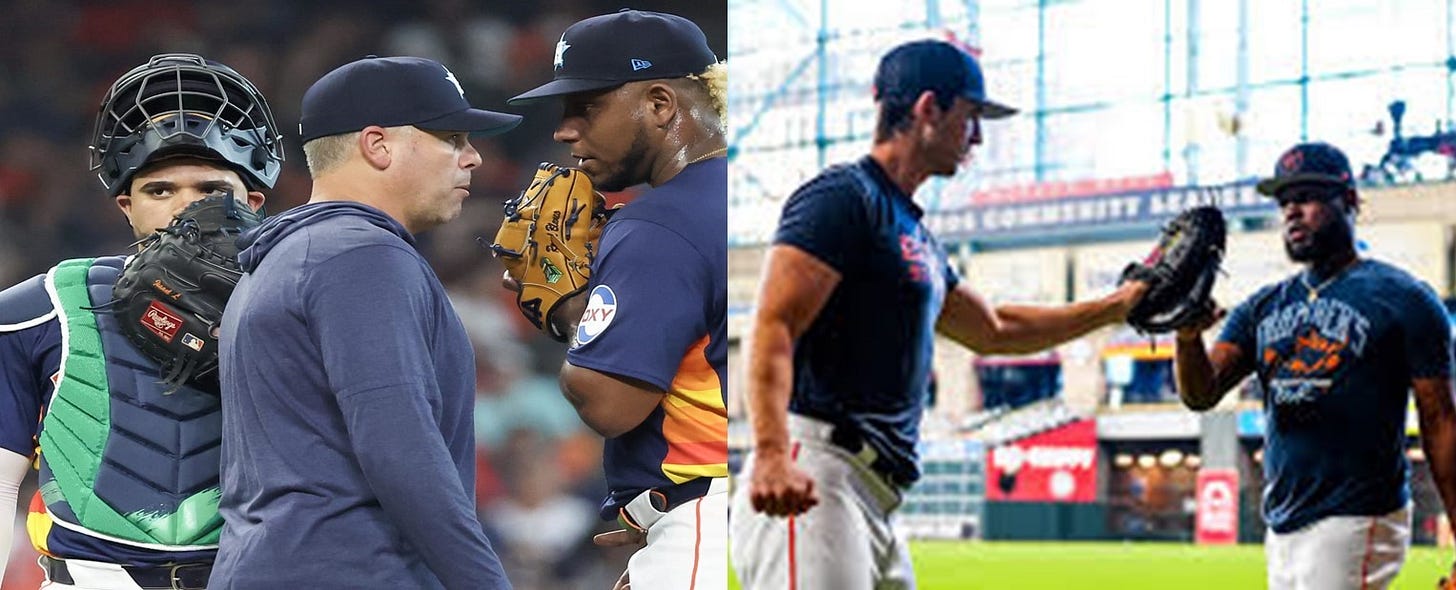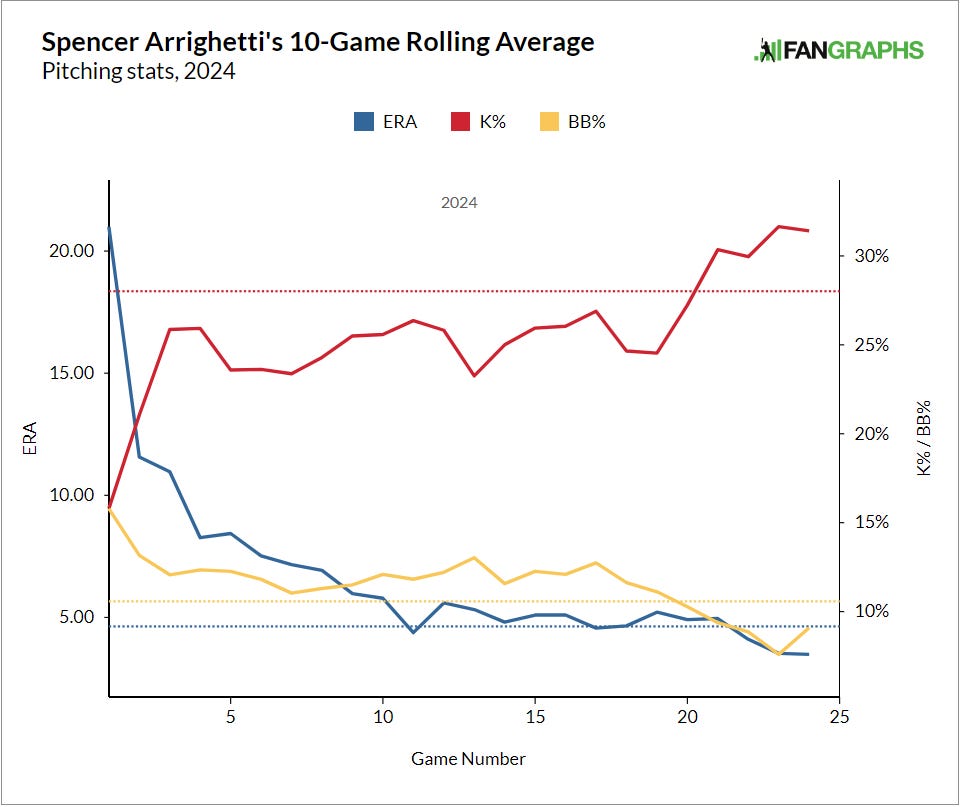The 2024 Astros MVPs: Pitching Coaches Josh Miller and Bill Murphy
A disastrous start, injuries, and building a bullpen from cast-offs have created big challenges for the Astros pitching coaches this season. They've exceeded expectations.
The last time Hunter Brown faced Kansas City, it was a disaster. On April 11, Brown allowed 9 runs, 11 hits and 1 walk against the Royals while retiring only 2 batters. And it was the height of the disaster that was the Astros pitching in the first part of the season.
Last night, it was a completely different story in Brown’s outstanding start against the Royals. Brown allowed 2 hits, 2 walks, and 0 earned runs while striking out 4 in 6.2 innings.
Spencer Arrighetti similarly had a disastrous start in Kansas City. One day before Brown’s start, Arrighetti made his major league debut. He’ll try to avoid telling his grandkids about it. Kansas City hitters tagged him for 7 runs on 7 hits and 3 walks in just 3 innings.
Two days ago in Philadelphia, it was also a completely different story for Arrigheti, as he only 2 hits and 4 walks while striking out 11 in 7.2 innings.
These last two games have been an advertisement for the turnaround of the Astros pitching staff. And it has been the Astros pitching staff that has keyed the team’s run to the top of the AL West this season.
Why did the pitching staff turn their season around after a disastrous start to the season. I think the men most responsible for this are the Astros two pitching coaches—Josh Miller and his assistant Bill Murphy.
The Pitching Turnaround
The Astros woke up on April 26 at 7-19 on the season, and their starting rotation was in shambles. Brown and Arrighetti were off to poor starts; Justin Verlander started the season on the IL, and Framber Valdez and Cristian Javier had found their way there; somebody named Blair Henley made an April start.
The team had a 5.07 ERA, 3rd highest in the majors and strikeout rate for 20.7%, good for 25th lowest. And while we did not know it then, little help was coming—Lance McCullers and Luis Garcia would not be able to return from their 2023 arm surgeries, Verlander had a longer IL stint ahead of him, and Cristian Javier’s return from the IL would be short-lived—he would soon need Tommy John surgery.
Josh Miller and Bill Murphy had to make the pitchers he had at that time better. This was a big challenge because his rotation featured a converter reliever in Ronel Blanco, a debutante in Arrighetti, and a young pitcher in crisis in Hunter Brown. This was a huge challenge.
Yet each of these three gave the Astros more than anyone would have expected on Opening Day, much less after the disastrous start. And a big part of the reason these three gave the Astros more than expected was the work that Miller and Murphy did with each of these pitchers.
Adjustments That Improved Blanco, Brown, and Arrighetti
With Blanco, the work was done primarily in the offseason. On a trip to the Dominican Republican this winter, Murphy “tinkered with Blanco’s grip” on his changeup. This grip change worked wonders.
Last season, Blanco threw only changeups 9.0% of the time.. This year, he has thrown them for 23.5% of his pitches. And the results have been outstanding. Opponents have a .191 batting average against Blanco’s changeup and only a .376 slugging percentage. It has produced a whiff rate for 35%, the best of his top three pitches. The Stuff+ metric rates it as 21% better than league average, and the 6th best changeup among major league starters (minimum 100 innings).
Overall. Blanco has been a godsend to the rotation, sporting a 3.14 ERA as opponents have slashed .191/.272/.364 against him this season. Most importantly, Blanco has been steady in the rotation, taking the ball for 25 starts in a rotation, a career high in any season of Blanco’s career.
With Hunter Brown, his turnaround from his disastrous start in Kansas City was his willingness to use a new pitch—a sinker or two seam fastball. The sinker itself is not a high quality pitch, but it works extremely well as part of Brown’s overall pitch mix. Brown also throws a four seam fastball, a cutter, and a curveball, all of which move from toward his glove side. By adding in a sinker, Brown now has a pitch which moves in on right handed hitter, keeping them from sitting on the outside corner.
The pitch also “tunnels” well with his cutter—the sinker and the cutter both follow a very similar path out of his hand toward the plate before breaking. It keeps batters from committing early to a pitch and makes it harder for them to identify pitches which will leave the strike zone. This has allowed Brown to manage contact very well—he is at the 92nd percentile in barrel rate, 97th in hard hit rate, and 78th in ground ball rate (ground balls can neve be homers).
Since adopting the sinker in a May 5 start against Seattle, Brown has a 2.40 ERA in 124 innings pitched, allowing opponents only a .598 OPS, with 131 strikeouts and only 40 walks. The turnaround is remarkable.
The credit for this pitch mix change has—oddly in my opinion—gone to third baseman Alex Bregman—who Chandler Rome has reported encouraged Brown to throw the sinker. It’s hard for me to believe that idea for this came from a third baseman. More likely, Bregman offered a hitter’s perspective that sold Brown on the conversations he was having with Miller and Murphy to make change his pitch mix. I’m giving the pitching coaches lots of credit here, and an assist to Bregman.
With Spencer Arrighetti, there is not a story of a new grip or pitch mix change, but instead, one of steady progress and improvement. Below is a chart of Arrighetti’s ERA, strikeout rate, and walk rate over the course of the season. And in all three measures—the most important to assess a pitcher I would argue—we see steady improvement over the course of the season.
Arrighetti began poorly on all three measures (see his debut in Kansas City) but has lowered his ERA and his walk rate over the course of the season while increasing his strikeout rate. And there is a clear improvement over his last few games in strikeouts and ERA. In short, guided by Miller and Murphy, Arrighetti has continued the strides he made in the minor leagues to develop into a major league pitcher.
A Successful Pitching Infrastructure
The point about Arrighetti’s minor league development also raises a more important point about Miller and Murphy’s role on the Astros. They are the major league pitching coaches, but they sit on top of an entire Astros pitching development system. They are the faces—especially Miller who has the most prominent role as the person who interrupts games to hold mound meetings with pitchers. But these two are part of a broader Astros pitching development infrastructure.
That infrastructure was tested greatly this season as four starting rotation options have been unavailable due to injury. The infrastructure was also tested as the front office took a new approach to building the back of bullpen, signing a bunch of castoffs from other teams to sort through and find what could stick in the bullpen.
One of these successes is Kaleb Ort, who is a journeyman reliever, and has shuttled back and forth between AAA and majors across 4 organizations over the last 6 seasons. Over 1097 batters faced at AAA and the majors in the Yankees, Red Sox, and Orioles organization, Ort walked 12.1% of the batters he faced. Against 115 batters he has faced in Sugar Land and in Houston, Ort has a walk rate of only 8.7%. He’s also increased his strikeout rate from 29.8% to 33.9%.
Ort is a find, as he has 17 strikeouts and only 2 walks in 14.1 major league innings. But more likely, Ort is someone who has been improved the Astros pitching lab, headed by Miller and Murphy.
We see something similar with Yusei Kikuchi, a veteran pitcher with a long track record. In five starts in Houston, he has a strikeout rate of 31.0%, higher than the 23.8% he has recorded over his career and the 26.2% rate he had earlier this season with Toronto. The chart below which shows Kikuchi’s pitch mix from July (with the Blue Jays) through August (with the Astros). The Astros changed his pitch mix, increasing usage of his slider and decreasing usage of his curveball. It’s worked as well as can be expected so far.
A Big Challenge in 2024
Overall, the Astros have had to rely on their pitching development to improve the team this season. This has required work from the minor league coaches, from front office analytic types, and from the major league coaching staff. At the head of this infrastructure are the major league pitching coaches—Josh Miller and Bill Murphy.
After the 2021 season, long time Astros pitching coach Brent Strom stepped down from the job because, Strom thought “this organization’s in a really good position with these two young pitching coaches that we have…“I think this organization deserves these two young guys, Murphy and Miller, to stay.”
Having Miller and Murphy stay worked well in 2022 as the Astros won 106 games and a World Series on the backs of the team’s pitching. That showed the Murphy and Miller could meet the minimum requirements of the job, but that season did not really test their mettle as pitching coaches. The season went mostly smoothly as five pitchers made 25 or more starts, Lance McCullers returned from a different arm injury, and only 8 starting pitchers were needed.
2024 has been a much greater challenge to Miller and Murphy due to the injury situation in the rotation and the need to find and develop bullpen options off the scrap heap of other team.
And yet, Astros pitchers have thrived. Since the nadir in late April, Astros pitchers lead the majors in ERA. They are 2nd in strikeout rate, 3rd in WHIP, and 5th in strikeout rate minus walk rate. In short, they have been one of the best pitching staffs in baseball over that period, one that now stretches 108 games—which is two-thirds of major league season.
And of those 108 games, the Astros have won 65 of them, which is a .601 winning percentage. After the 7-19 start, the Astros were 7 games back in the AL West. Today, they have improved 11 games on that margin and are 4 games up on the Mariners.
It’s the Astros pitching which is responsible for the turnaround. And I think it’s Josh Miller and Bill Murphy who are most responsible for the improvement of the pitchers.
Can you give a team’s MVP award to it's pitching coaches? If so, I would vote to give it to Josh Miller and Bill Murphy.






